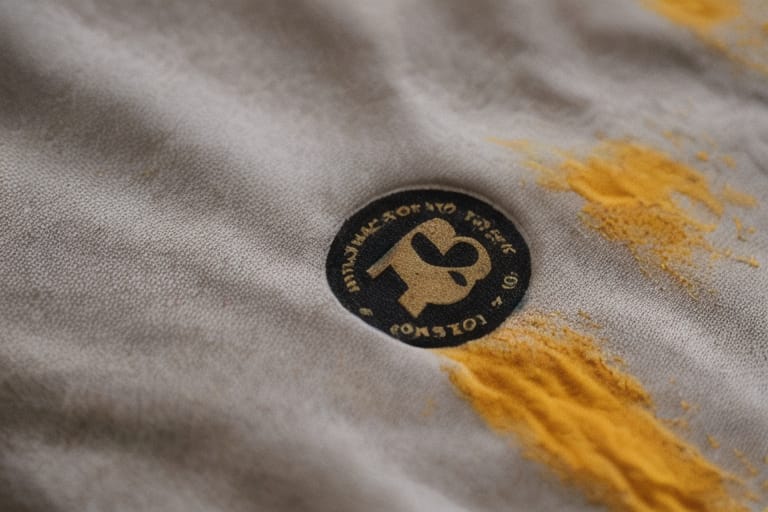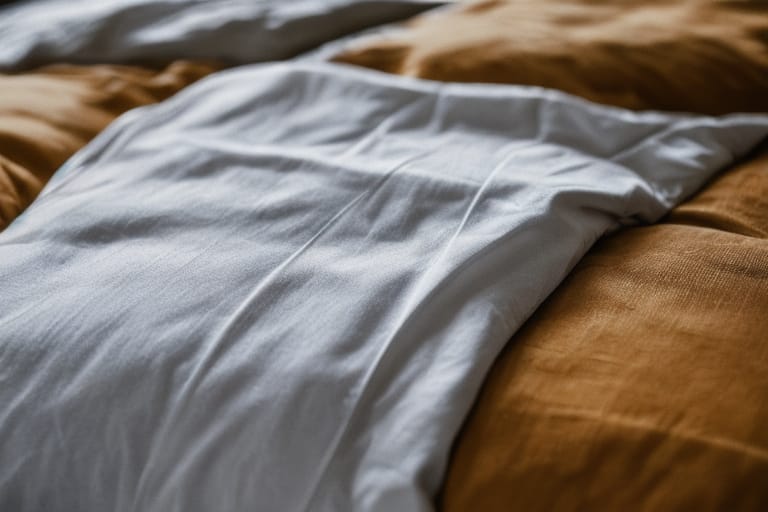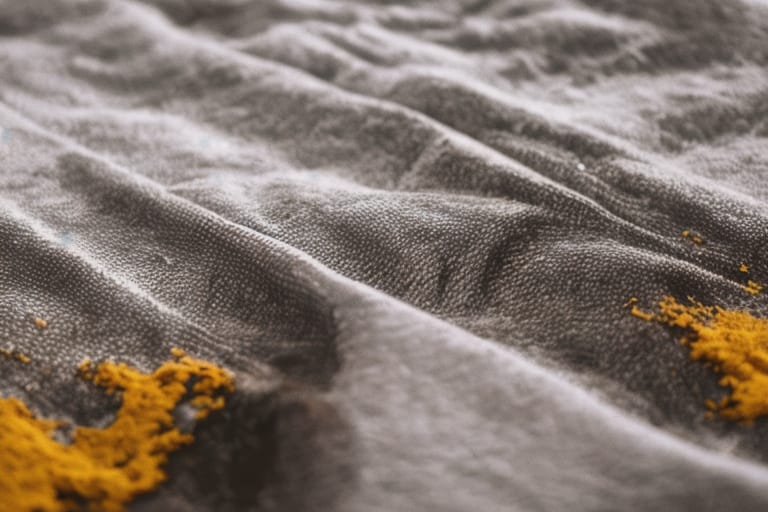Have you noticed your down comforter gradually turning an unsightly yellowish hue? The discoloration is often most pronounced in the center where your body directly contacts the comforter. This yellowing not only detracts from the aesthetic appeal of your bedding but may also signal the buildup of body oils, dirt, and skin cells that can degrade the comforter and pose health risks.
In this beginner’s guide, we’ll explore the common culprits behind comforter yellowing and simple tips to restore your bedding to its original pristine white state. Discover what causes the yellow stains, how to properly wash and care for down, when to call in the professionals, plus preventative steps so it stays looking bright and fresh.
What Causes a Down Comforter to Turn Yellow?
Down comforters consist of a cozy, fluffy filling made from duck or goose plumage enclosed within a casing or duvet cover typically made from cotton, microfiber, polyester or other fabrics. This filling is highly susceptible to discoloration from body oils and sweat that naturally rub off your skin during sleep. Add in environmental factors like humidity and heat, and you have the perfect formula for yellowing over time.
The main contributors to comforter discoloration include:
- Body oils: The skin naturally secretes oils like sebum even more so when overheated while sleeping. These oils leave behind yellow stains.
- Sweat: Perspiration from your body permeates the down during hot humid weather or night sweats. The sweat residue causes yellowing.
- Dead skin cells: Shedding skin cells mix with oils to create yellow discoloration.
- Humidity: Dampness in the air leads to musty odors and fabric degradation.
- Heat: Warm temperatures facilitate the breakdown of fabric and cause heavy perspiration leading to staining.
- Sunlight: UV exposure accelerates the yellowing process by bleaching and fading dyes.
- Dust mites: Microscopic mites feed on the keratin in old skin cells and leave behind yellow excrement stains.
- Soiling: Environmental dirt and pollutants settle into the down after inadequate or improper washing.
How To Clean Yellow Stains From a Down Comforter
Restoring a yellowed down comforter to its original white luster takes a bit of strategy and elbow grease. Proper cleaning techniques can effectively remove years’ worth of staining without damaging the delicate duck or goose plumage fill.
Supplies You’ll Need
- Mild liquid detergent or specialty down wash
- White vinegar or lemon juice
- Large capacity washing machine
- Extra-large laundry bags
- Tennis balls (at least 3)
- Extra towels
Step-By-Step Washing Guide
Follow these key steps to clean even the most stubborn stains from your down comforter at home:
- Check the care label first: Read the manufacturer’s instructions to understand any special washing requirements or fabric limitations before proceeding.
- Pre-treat any heavy stains: Focus on yellowed areas and treat with a diluted vinegar solution or enzyme-based pre-wash stain remover before the main wash cycle.
- Use a large capacity machine: A heavy-duty top or front loading washing machine with a central agitator works best for cleaning large items like comforters. Make sure to leave plenty of room for the down to move around freely during the cycle.
- Wash using cold water on a gentle cycle: Hot water can damage or shrink delicate fabrics and down fill. Stick with cold water and choose the most delicate cycle setting.
- Use mild detergent only: Steer clear of harsh bleaches, brighteners, and powders meant for heavily soiled loads. Ultra-concentrated and plant-based liquid detergents formulated specifically for down work best.
- Add vinegar to the rinse cycle: White vinegar helps restore brightness by removing leftover soap residue and hard water mineral deposits. Pour 1⁄2 to 1 cup into the fabric softener dispenser.
- Dry thoroughly on low heat: Excess moisture allows down to compress and clump together leading to uneven spots. Add a couple clean tennis balls to the dryer to help break up clumping as it tumbles.
Pro Tip: Let your comforter air out on a clothesline or drying rack in direct sunlight periodically to help naturally bleach and renew the white color.
When To Call In The Professionals
For down comforters with extensive staining or ones made from delicate fabrics like silk, consider enlisting professional dry cleaning help. Reputable companies use commercial-grade equipment and eco-friendly solvents that can lift years of embedded grime without damaging the filling or shell fabric.
Many also offer advanced stain removal treatments and deodorizing processes ideal for sanitizing heavily soiled bedding. Expect costs starting around $25 per comforter increasing with the size from twin up to California king.
While certainly convenient, repeated dry cleaning can get expensive over time and involves chemical solvents. For the budget and earth-conscious, try restoring that yellowed comforter yourself first before calling in the pros.

Can You Prevent A Down Comforter From Turning Yellow?
An ounce of prevention truly pays off when caring for higher end bedding. While you can’t completely prevent the natural secretion of body oils and sweat, you can take proactive steps to curb staining and extend the pristine look of your down comforter.
Choose a Stain-Resistant Cover
Encasing your down comforter in a removable duvet cover serves as an inexpensive shield against those pesky body oil and dirt stains. Look for ones designed from tightly woven, high thread count fabrics enhanced with hydrophobic and antimicrobial finishes. Popular “performance bedding” collections from brands like Brooklinen, Parachute and Buffy even withstand night sweats and keep hot sleepers drier throughout the night.
Wash Twice A Year
Don’t be tempted to take shortcuts on cleaning something nestled so close to your body every night. Aim to launder your down comforter at least twice yearly to control buildup of oils, sweat, dust mites and other nose-wrinkling grime. For duvet covers, wash every 2-3 weeks.
Alternate Comforters By Season
Consider owning multiple down comforters of varying warmth levels suited to cold winter versus hot humid summer weather. Rotate their use each season to allow a prolonged break from direct body contact when stored away. The respite starves dust mites of their main food source and curbs staining. Just be sure to wash the comforter before storing to rid any remaining skin cell evidence.
Air Out Often
Make a habit of fully opening up your bedding layers to air out for 20-30 minutes before remaking the bed each morning. Allowing humidity and heat to dissipate inhibits the growth of odor-causing bacteria and yellow discoloration over time.
Store Properly When Not In Use
During prolonged periods of non-use like summer months, avoid cramming comforters into vacuum seal bags or dark closets. Instead store folded loosely in breathable cotton cases placed in well-ventilated spaces safe from direct sunlight. Adding cedar blocks or sachets of dried lavender can also deter any nascent moth infestations from damaging stored down.
Does Fill Power Impact Discoloration?
The loft and fluffiness of a down comforter depends on the fill power which measures the space one ounce of compressed down occupies in cubic inches. Higher fill equals greater insulation since more trapped air gets trapped between the clusters and feathers. But does fill power also influence the yellowing rate?
Generally down with fill power from 600 to 800 is best suited for comforters and bedding use. Much lower than 600, the more quill-like feathers can readily poke through casing fabric leading to leakage over time. Ultra-high fill over 800 also poses challenges requiring baffled channel construction to prevent shifting and maintain even distribution.
As far as discoloration goes, there is no direct correlation between fill power and propensity for yellow staining. Far more important is choosing a tightly-woven, high thread count shell fabric engineered to resist leaking and properly contain the down. Paying a bit more upfront for quality materials like long-staple Egyptian or Pima cotton, premium microfiber or high-tech moisture-wicking fabrics better contains those staining culprits over the long run.
Average Costs of Down Comforters by Fill Power
| Fill Power | Price Range |
|---|---|
| 400-500 | $50-$150 |
| 600-650 | $150-$300 |
| 700-800+ | $300+ |
Is Down or Synthetic Fill Less Prone To Yellowing?
For those wary of animal products, down alternative comforters offer a vegan solution stuffed with various synthetic fills to mimic the warmth and puffy feel of luxury goose or duck down at a more budget-friendly price point. But how do they compare regarding yellow discoloration issues?
Down vs Down Alternative Comforters
| Attribute | Down | Down Alternative |
|---|---|---|
| Fill Material | Goose/duck plumage | Polyester, microfiber |
| Warmth | Excellent, lofty | Good, less breathable |
| Price | $$$ Higher | $ More affordable |
| Odor Resistance | Fair, needs frequent washing | Good, less cleaning needed |
| Yellowing Resistance | Fair, attracts body oils | Good, more stain resistant |
The hydrophobic synthetic fibers found in quality down alternative fills like PrimaLoft and ThermoSmart repel liquids better than natural downs. As such, they resist absorbing those staining body oils and sweat droplets common during sleep.
Most down alternative shell fabrics also undergo chemical treatments to enhance water repellency and stain resistance adding further armor against yellowing issues over time. So while synthetic fills lack the unparalleled coziness of premium goose down, they compensate by maintaining their loft and brightness longer between cleanings.

Frequently Asked Questions
What is the best way to clean vomit or urine stains from my down comforter?
For protein-based stains like vomit or urine, immediately blot up excess moisture using paper towels followed by an enzymatic cleaner like Nature’s Miracle designed to break down organic matter. Avoid rubbing or scrubbing motions that presses messes further into the down fill. Rinse cleaner residue thoroughly before laundering as normal.
Can I put my comforter in the dryer after air drying?
Yes, tumble drying for 15-20 minutes on low heat after fully line or rack drying further fluffs up the down filling and ensures no hidden moisture remains nested inside. The secondary dryer cycle also helps renew bright white coloring.
How do I add tennis balls to my dryer to fluff a comforter?
To properly redistribute and aerate the fill inside a comforter, add 2-3 new fuzzy tennis balls to your dryer drum before starting the cycle. Their motion and texture helps break up any clumping fill and keeps things lightweight and lofty. Remove balls immediately after drying completes or they may damage the fabric over time.
What temperature water should be used to wash a down comforter?
ALWAYS use cold water on the gentle or delicate cycle setting to wash any down bedding. Hot water risks excessive agitation that can damage the comforter shell fabric or cause the baffles to separate. Cold water adequately lifts stains when paired with mild detergent and extended soaking.
Can I put a comforter in the washing machine or does it need professional cleaning?
Home washing machines can handle all but the very largest king-sized comforters IF you use the right gentle settings, detergents, and dryer balls as outlined above. Dry clean only labels on down bedding refer mainly to the shell fabric’s delicacy versus the actual feather fill. Still air out and spot clean your comforter whenever possible before full washing to prolong its lifespan.








